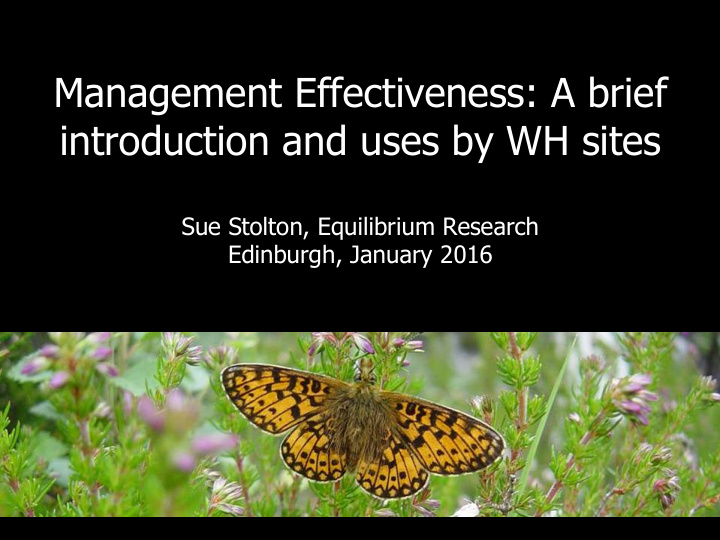



Management Effectiveness: A brief introduction and uses by WH sites Sue Stolton, Equilibrium Research Edinburgh, January 2016
A presentation in four parts 1. Introduction to the concept of management effectiveness 2. Introduction to the Enhancing our Heritage toolkit 3. Linking management effectiveness to management systems and plans 4. Links with other World Heritage processes
1. Introduction to the concept of management effectiveness
‘…the assessment of how well an area is being managed – primarily the extent to which it is protecting values and achieving goals and objectives ’ (IUCN WCPA, 2006)
A quick history • Management effectiveness raised by IUCN’s World Commission on Protected Areas (WCPA) in 1983 • Independent systems developed during 1990s assessing a few hundred sites worldwide • Publication of WCPA Best Practice Guidelines in 2000 and revised Best Practice Guidelines in 2006 • By 2016: 20,000 sites evaluations, in 180 countries using several tools based on the framework
The WCPA Framework https://portals.iucn.org/library/efiles/documents/PAG-014.pdf
Best practice publication • Defines terminology • Develops a framework of assessment criteria • Detailed advice on carrying out an assessment and using the results • Case studies concentrating on the process of carrying out an assessment
Management follows a process
Begins with establishing the context of existing values and threats That results Progresses in impacts or through outcomes planning Management planning cycle Produces Allocation of goods and resources services ( inputs ) ( outputs ) As a result of management actions ( processes )
2. Enhancing our Heritage (EoH) Developing a standardised assessment system for natural World Heritage sites
Objective of the EoH project Work with managers of natural World Heritage sites: • Developing assessment, monitoring and reporting systems based on adapting the WCPA Framework • Applying results to adapt or enhance management • Consider how these systems could be used in natural World Heritage properties
• Introduces management effectiveness concept • Discusses assessment processes • Explains and details the tools developed • Includes case studies of trial sites • Explores application to cultural sites • Reviews next steps • whc.unesco.org/en/ series/23/
EoH Toolkit • Built around the WCPA Framework • 12 tools which can assess a range of indicators within the Framework • Many tools drawn from best practices around the world - but often simplified
The tools
Format of tools • Wording specific to natural WH sites but easily adaptable to any protected area and to cultural sites • Most assessments are qualitative, drawing on monitoring results: – data sheets assessing strengths / weaknesses – rating assessment against best practice benchmarks • Quantitative data is used in assessments of inputs, outputs and ideally in outcomes
EoH Toolkit • Tools can be adapted to suit a site’s individual needs: – supplement existing assessment activities – point of reference to develop new assessment tools to meet site needs – build a complete assessment system – Feed into the development of management systems and plans
Linking the natural with the cultural • Natural sites: biodiversity, other natural values + cultural, economic, educational values etc • Cultural sites: material fabric and social context + cultural, economic, educational values etc • Cultural systems and intangible characteristics not easy to assess • Less experience in developing indicators for monitoring and evaluation in the cultural field
3. Linking management effectiveness to management systems and plans
An effective management system: • cycle of planning, implementation, monitoring, evaluation and feedback • assessment of the vulnerabilities • involvement and shared understanding of partners and stakeholders • allocation of necessary resources • capacity-building • accountable, transparent description of how management system functions Operational Guidelines (para 111)
What makes a good plan? Key elements of a management system: • Provide clear direction for management • Link management objectives to values (OUV) • Direct activities and enable work plan to focus on achieving these objectives • Involve stakeholders in development, review and management activities • Be linked to realistic budgets and available resources • Have measurable and achievable targets/goals
How has the EoH toolkit been used in management planning • EoH pilot sites: over half used the EoH toolkits in the revision of their management plans • Application since then in Africa also linked to management plan reviews • Nordic region training to use EoH to develop management systems mainly in cultural World Heritage properties
4. Links with other World Heritage processes
Information Iceberg WCPA’s experience in management effectiveness contributed to the development of the on-line periodic reporting format Periodic Reporting EoH assessments help inform reactive monitoring (resulting in a site being removed from the in-danger list) Monitoring and assessment (EoH, reactive monitoring; national monitoring etc) Monitoring and assessment should be central to a site’s management system Site Monitoring Site Monitoring Site Monitoring Site Monitoring
IUCN WH manual and outlook • 2012 volume organised around the WCPA Framework so links the key elements of world heritage management with management effectiveness • http://whc.unesco.org/en/ managing-natural-world- heritage/ • Management Effectiveness experiences and framework also reflected in IUCN World Heritage Outlook • http:// www.worldheritageoutlook.iuc n.org/
Thank you
Recommend
More recommend